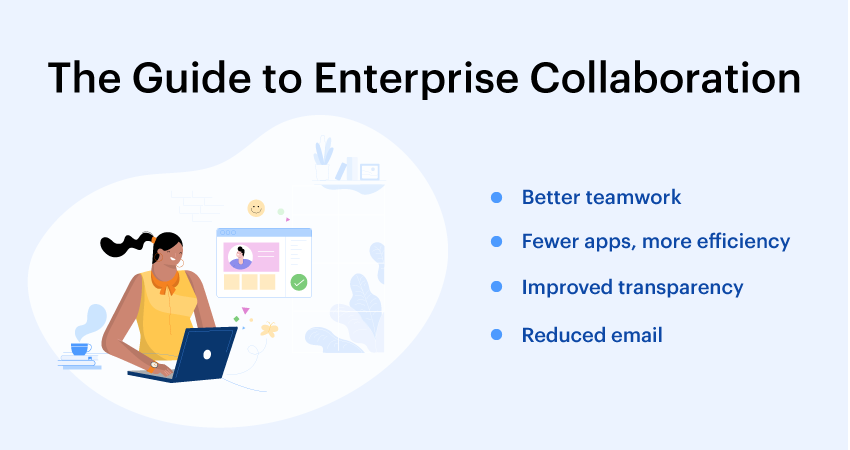
In the fast-paced world of business, staying ahead of the competition and streamlining your operations is crucial. One key aspect that can help you achieve this is enterprise collaboration. But what exactly is it? Simply put, enterprise collaboration is the process of working together with your colleagues, partners, and customers to achieve common goals and objectives. It involves sharing information, ideas, and resources to improve efficiency and productivity within your organization.
Now, you might be thinking, “Isn’t that just teamwork?”. While teamwork is an essential component of enterprise collaboration, it goes beyond that. Enterprise collaboration encompasses not only the collaboration between team members but also between different departments, stakeholders, and even organizations. It’s about breaking down the silos that typically exist in large organizations and fostering a culture of open communication and cooperation.
Enterprise collaboration is not just limited to face-to-face interactions; it also includes the use of technology to facilitate communication and collaboration. This is where an enterprise collaboration system comes into play. It provides the tools and platforms that enable your organization to collaborate effectively both internally and externally.
Table of Contents
How do you Define an Enterprise Collaboration System?
An Enterprise Collaboration System refers to a set of tools, technologies, and practices that facilitate communication, cooperation, and knowledge sharing within an organization. It is designed to enhance collaboration and streamline workflows among employees, teams, departments, and even external stakeholders.
The primary goal of an Enterprise Collaboration System is to promote effective collaboration and improve overall productivity by enabling individuals to work together seamlessly, regardless of their physical location or time zone. It provides a centralized platform where employees can share information, exchange ideas, coordinate tasks, and collaborate on projects.

The role of an enterprise collaboration system
An enterprise collaboration system is a suite of tools and technologies designed to facilitate communication, collaboration, and knowledge sharing within an organization. It helps bridge the gap between different departments, teams, and individuals, making it easier for everyone to work together towards common goals. By providing a centralized platform for communication and collaboration, an enterprise collaboration system helps break down the silos that can hinder efficiency and productivity.
An effective enterprise collaboration system should provide a seamless user experience, allowing users to easily access the tools and information they need to collaborate effectively. This may include features such as instant messaging, video conferencing, document sharing, and project management tools. The system should also be scalable and customizable to meet the unique needs of your organization.
One key aspect of a successful enterprise collaboration system is its ability to integrate with your existing IT infrastructure and applications. This ensures that users can continue to use the tools they are familiar with, while also benefiting from the added functionality and features provided by the collaboration system. This not only helps improve user adoption but also minimizes disruptions to your existing workflows and processes.
Key benefits of implementing enterprise collaboration
Implementing an enterprise collaboration system can provide numerous benefits for your organization. Some of the key advantages include:
Improved efficiency and productivity
When employees have access to the tools and information they need to collaborate effectively, they are more likely to complete tasks faster and with fewer errors. This can help improve overall efficiency and productivity within your organization.
Better innovation and creativity
By fostering a culture of open communication and collaboration, your organization can tap into the collective knowledge and expertise of its employees. This can lead to new ideas and innovative solutions to problems, helping your organization stay ahead of the competition.
Enhanced decision-making
Enterprise collaboration enables organizations to make more informed decisions by providing access to a diverse range of perspectives and insights. This can help reduce the likelihood of costly mistakes and improve overall business performance.
Increased employee engagement and satisfaction
Employees who feel connected to their colleagues and are able to contribute to the success of the organization are more likely to be engaged and satisfied with their jobs. This can lead to higher retention rates and a more positive work environment.
Stronger relationships with partners and customers
Enterprise collaboration extends beyond your organization’s walls, enabling you to work closely with partners and customers to achieve mutual goals. This can help strengthen relationships and improve customer satisfaction.
Essential features of a collaboration platform
When selecting an enterprise collaboration system, it’s important to consider the features that will best support your organization’s needs. Some essential features to look for include:
Communication tools: At the heart of enterprise collaboration is effective communication. Look for a platform that offers a range of communication tools, such as instant messaging, video conferencing, and discussion forums.
Document management and sharing: The ability to easily share and collaborate on documents is essential for efficient teamwork. Ensure your collaboration platform provides a centralized repository for storing, sharing, and working on documents together.
Project management tools: To keep projects on track and ensure everyone is working towards the same goals, look for a platform that includes project management features such as task assignments, progress tracking, and reporting.
Integration capabilities: Your enterprise collaboration system should be able to integrate with your existing IT infrastructure and applications, ensuring a seamless user experience and minimal disruption to your workflows.
Security and compliance: Safeguarding your organization’s data and ensuring compliance with industry regulations is crucial. Look for a platform that offers robust security features and supports compliance with relevant standards.
Get Your Collaboration Solution Form the Best
SVAM International is a leading provider of collaboration solutions, offering a range of services and technologies to help your organization achieve its collaboration goals. With years of experience in the industry, our team of experts can help you design and implement an enterprise collaboration system that meets your unique requirements.
In order to assist enterprises with complicated structures that can easily manage operations and make information exchange simpler, SVAM International examines the demand for an enterprise collaboration platform and integrates the ideal technology.
They develop comprehensive and in-depth collaboration solutions with the help of a skilled team of developers and analysts who are backed by the greatest technology currently accessible in the sector.
Conclusion
Enterprise collaboration is essential for organizations looking to stay competitive and improve their overall performance. By implementing an effective enterprise collaboration system, your organization can benefit from increased efficiency, productivity, innovation, and employee satisfaction. By partnering with a trusted collaboration solution provider, you can ensure that your collaboration system meets your unique needs and provides a strong foundation for your organization’s success.





More Stories
The Spark Shop – Online Shopping Big Discount: Your Ultimate Shopping Destination
TheSpark Shop Kids Clothes for Baby Boy & Girl: A Trendy Choice for Little Ones
The Ins and Outs of Knowledge Management (KM)